#how to navigate the norfolk broads
Text
I’m trying to reach 1000 subscribers by Christmas 😍 please #share everywhere online for me . I can film Live from locations at 1000 subscribers 🇬🇧🛥⛵️ thanks for helping
Ludham Bridge #fieldfare #boats #reflections https://youtu.be/GNVa9ZKC_70
youtube
#youtube#norfolk broads#travel#travel photography#traveling#holidays#new video#staycation#nature#please subscribe#autumn vacations#wildlife#ludham bridge#please share#1000 subscribers#wild birds in norfolk#how to navigate the norfolk broads#sailing holidays#norfolkbroads cruisers yachts sailing boats please subscribe to my youtube channel easterdailypress edp
1 note
·
View note
Text
You guessed it! We’ve become way behind here once again …
The weather’s been amazing these past few weeks, so unsurprisingly sitting indoors writing blog posts hasn’t featured at the top of our ‘to action’ lists. We’ve also been enjoying hosting our first two sets of Kiwi visitors of 2018 on board, and sharing laughter and experiences with them along the wonders of the waterways.
We know many people are anticipating seeing images of our return journey on the Lancaster Canal, back to Tarleton via the Ribble Link on Sunday 17th June; it’s even more special as we had brand new friends on board!
Sandra returns from a week in Menorca
After a life-changing few weeks, Sandra returned to Areandare from Malpas (via Menorca!) to Carnforth. It felt quite surreal to visit the Canal Turn pub with Barry and find herself subject of conversations about how lovely the Lancaster Canal and living on a narrowboat must be, when she was yet to experience anything about the waterway. It was most discombobulating and took a few days to adjust and begin to appreciate our inaugural journey in this long anticipated place. …
Barry captured the journey magnificently as usual, and captioned the images well. Enjoy …

Carnforth Station is a very handy railway junction giving access to both North/South travel as well as East/West and boasts the longest unsupported single piece concrete roof in Britain.
Carnforth Railway Station was the setting for the 1945 David Lean film ‘Brief Encounters’, starring Celia Johnson and Trevor Howard, and contains a museum to Sir David Lean CBE as well as a museum containing a history of the station and its restoration.
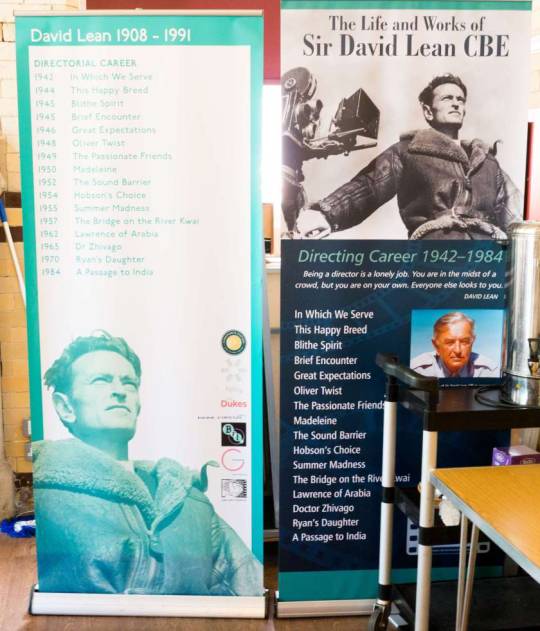
Barry’s NZ friend Keith’s father, Douglas Twiddy, from Borehamwood/Elstree, worked with David Lean on three of the above films. Lawrence of Arabia, Doctor Zhivago and Ryan’s Daughter, amongst many other films he was involved with such as Raiders of the Lost Ark, Return of the Jedi and Labyrinth.
Keith emigrated to Gisborne in 1973, and Barry and he met through playing badminton. They subsequently then ‘flatted’ together for a number of years. In 1976, Keith, Barry and friends John and Vicki, visited the UK stayed for a while with Doug and Ena at Borehamwood. It was during an excursion with John and Vicki when Barry first spotted the Norfolk Broads and the canals at Northampton (hence the waterway connection).
Keith’s mum and dad visited Gisborne in 1980 for Keith and Cheryl’s wedding, and while there scouted the area for filming locations as ‘Production Supervisor’ for the 1984 film The Bounty starring Mel Gibson, Anthony Hopkins, Lawrence Olivier, Daniel Day Lewis, Liam Neeson etc. It also starred Neil Morrisey, owner of The Plume of Feathers pub at Barlaston near Stoke on Trent (another waterway connection).
The film company converted the old brick facade of the waterfront Freezing Works in Gisborne to look like the Docks at Bristol (yet another waterway connection!). Barry recalls they had a full-sized replica of the ship moored in the harbour basin, with huge wooden chutes that sent torrents of water over the deck for the storm scenes.
Barry remembers being invited aboard ‘The Bounty‘ after the pub late one night, with his mate Lee, and forcing Mel Gibson to wait to disembark as they boarded, and then ended up later climbing the rigging and singing silly sailor songs (no recognisable connection to the waterways).

The famous clock used in the film, though the film used a cardboard cutout face over it to keep filming continuity.

… then it was back onto the return journey
Our travels took us past many gorgeous back garden settings, one swing bridge, and just occasional teasing glimpses of Morecambe Bay in the distance.


A marvellous time of year watching cygnets maturing

The permanent moorings at Hest Bank where we stopped for a visit to the beach!
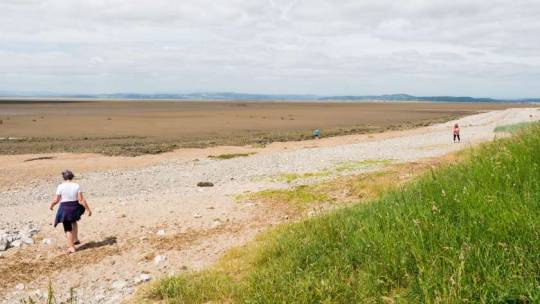
Where has all the water gone?
You do feel like you’ve got all the time in the world to explore the mud flats. However …
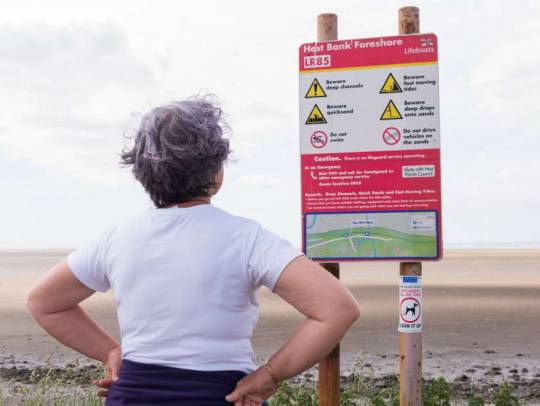
There are dangers aplenty!
We read the heartbreaking story of the 21 Chinese illegal immigrants who drowned needlessly and helplessly in 2004. It’s become known as the ‘Morecombe Bay Cockling Disaster‘. A shocking indictment on how humans are able to knowingly abuse their fellow-man at times …

We crossed the Hest Bank railway and seemed to wait forever for this engine to come down the long straight for Barry to get a photo, then realised it was carrying nuclear waste and decided waste and haste don’t mix!

A short stop at the Lune Aqueduct for Barry to get some photographs for a future greeting card.
The Lune Aqueduct is one of John Rennie’s master-piece-aqueducts, completed in 1797, at a total cost of £48,320 – only £30,000 over budget – not too bad! We saw no leaking now after the repairs of 2011-2012, or even any signs of much wear and tear. It looks in pretty good nick!
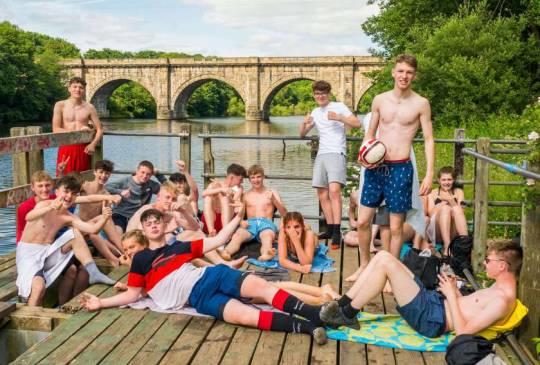
These fun-loving kids, enjoying themselves swimming and taking in the sun, felt they needed to be an added foreground feature of the aqueduct.

At 664ft long, 20ft wide and 61ft high it’s an impressive structure – Sandra can just be spotted driving Areandare slowly along the structure
Looking back we’re rather incredulous as to how we fitted so much in during this journey. Sandra returned to Areandare on Tuesday 5th June, we cruised to Lancaster on Wednesday 6th (and visited the above places en route), then had dinner at the Water Witch pub there with a previous midwifery colleague of Sandra’s who lives nearby (sadly neither Sascha or Sandra took a photo, they were far too busy catching up!), then on Thursday 7th June Sandra jumped on a train heading to her mum’s for a weekend of sorting with her sisters. Barry followed the next day, and we both travelled back to Lancaster on Sunday 10th.
Phew!
Onto the Glasson Branch
Leaving Lancaster on Monday 11th June, we headed south and turned right to the Glasson Branch. Barry had been eagerly anticipating this detour. We’re so thankful we chose to take this route – especially as it’s currently un-navigable due to water shortages …

Then it was down the Glasson Branch to the docks. Just under three miles and six locks.

A picturesque run down through the lush countryside

Looking back up the canal with The Pennines in the background

The docks are an extensive area of water with a sea going marina and this lock down to the harbour basin
There’s quite a stark contrast between the dock moorings and the adjacent tidal estuary.

The massive Heysham Nuclear Power Plant across the Lune Estuary from Glasson Dock

Also looking across the estuary to the little fishing village of Sunderland.
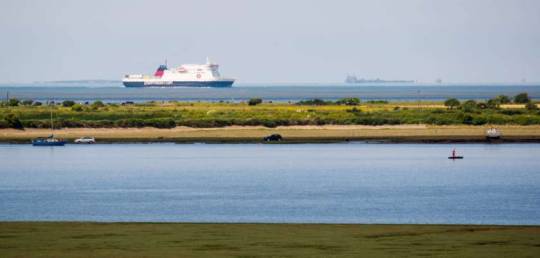
The ferry that runs from Heysham to Douglas on the Isle of Mann
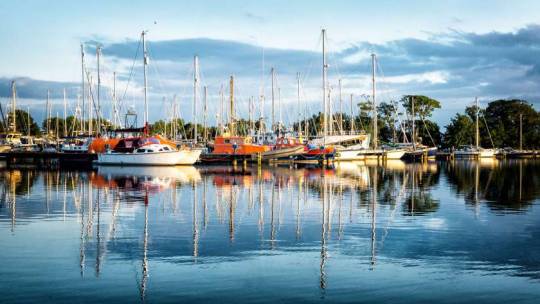
Late light on the yacht moorings opposite us.
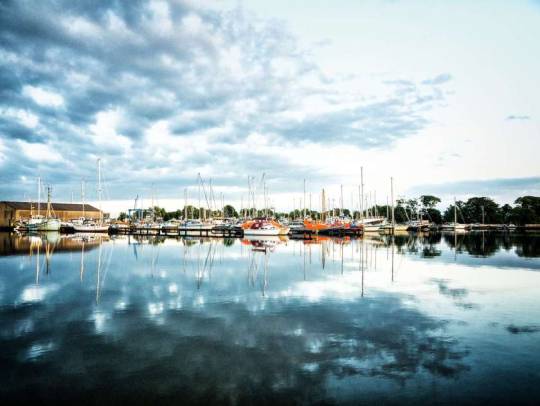
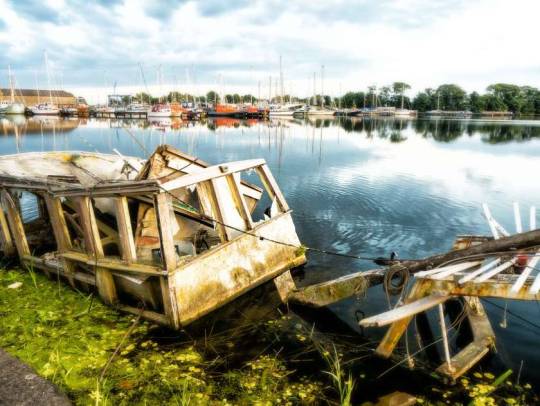
A bit of a ‘do-er upper’ resting on the moorings!
As you can see, the incoming tide is far quicker than watching paint dry!
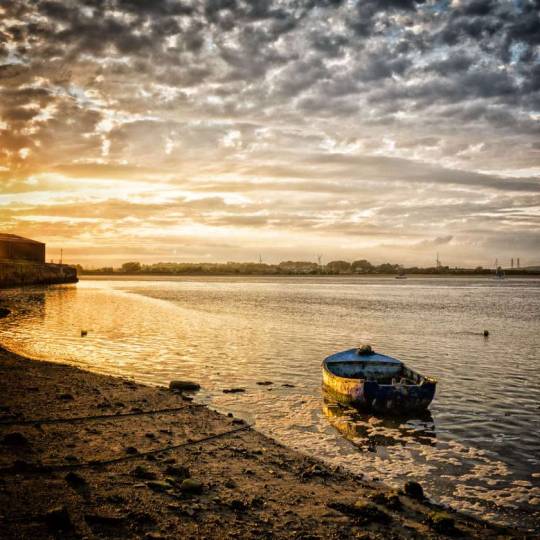
What a difference a bit of water makes!

Our mooring in the docks

Barry just can’t help adding a couple more images of the marina – he was very impressed by it!

Next day we awoke to a fishing boat waiting to get through the lock and into the harbour, then through the sea lock onto the estuary. Barry delayed his breakfast and took his camera out for an early morning jaunt.
Two CRT workers were there to lock the boat through. They used to have to be on duty here whenever the tides were right, even if nobody was wanting to go through, but now boaters have to ring and book passage. It makes perfect sense to Barry, but apparently not to some boaters who expect service on demand!
It’s quite an effort and rather complex to work the lock, as it also has a swing bridge across with a very busy road over. It’s serious work winding the paddles, then the gates, and synchronising the timing to cross the harbour and exit the sea lock before the tide gets too low.

Boats moored in the semi tidal harbour.
The sea lock apparently doesn’t hold all the water out, and it lowers with the tide …

… so the moored boats get left stranded aground for a time while the two levels equalise.

Then of course any traffic can shoot out of the entrance.

Christ Church near the docks
We had a number of walks around the Docks and Estuary during our stay, and took the opportunity to visit the Port of Lancaster Smokehouse too. A few fellow boaters had recommended it. Sandra enjoyed Morecambe Bay Whitebait (memories of childhood), we both relished Morecambe Bay prawns, and over the course of the following days ate like a King and Queen with smoked mallard breasts (yes, we know, not in the best taste really, and wouldn’t bother again as though tasty there’s not a lot of meat on them!), smoked pheasant breasts (read it carefully!), smoked Lancashire cheese, smoked butter, smoked bacon, sausages, and venison smoked sausage. We’d expected to taste black and white pudding, but didn’t realise it hadn’t been put in the bag and it was too late by then to go back. So that experience will have to wait until another day …
Back to Savick Brook
Most people reading be aware the journey across the Ribble Link needs to be booked by license holders through CRT (using their log-in details) , well in advance, and there’s limited availability during the season. Our return trip was planned for Sunday 17th June, so after a couple of days at Glasson we needed to resume our travelling.

Time to head back up the canal to the main line. We’ll be back!
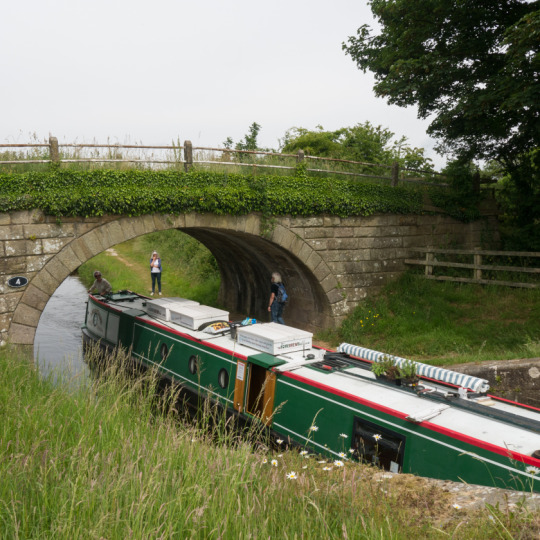

Now back on The Lancaster Canal, Abraham keeps an eye on passing boats.
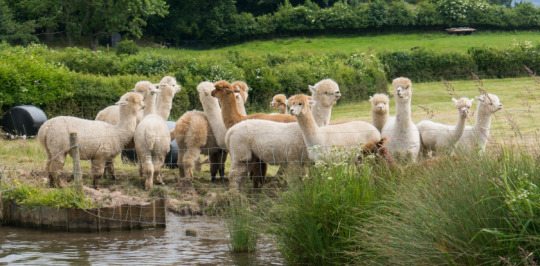
Don’t be too A’Lama’ed!
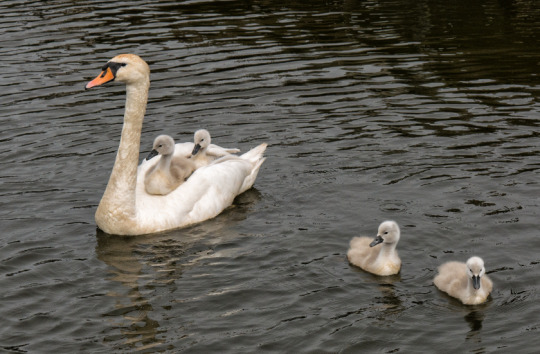
Hitching a ride
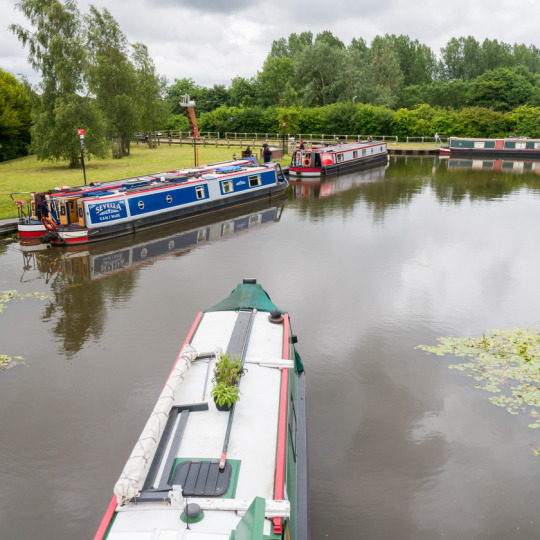
Back now at the top lock and basin at Savick Brook, the beginning of the Ribble Link.
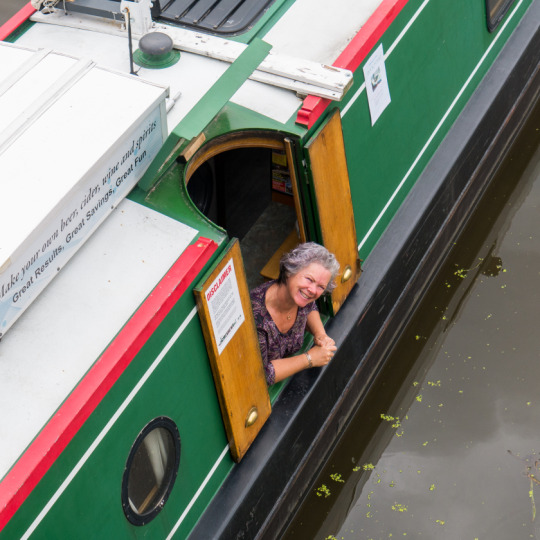
Just the touch of a nervous smile.
It’s a very twisty, narrow, and shallow navigation down the Savick Brook link. It’s just under three miles, and involves nine locks, including the sea lock, and a triple staircase lock at the top that you have to reverse into. It’s a fascinating and slightly formidable journey!
Gareth and Michaela had offered to travel from York to crew with Barry on the outgoing trip, just after Andy had been in touch. So we suggested they may want to come along for the ride on the return. They were very keen to – so much so they even brought a delicious spread for lunch too! What a bonus.
The following first group of photos isn’t up to Barry’s standard, they’re Sandra’s poor efforts … you’ll easily notice the difference when Barry’s recommence!
In the first lock …
Micheala and Gareth seeming delighted to be back on board a narrowboat
A little shallow at times
And out onto tidal waters …
Gareth driving like a pro
Happy boys at the tiller
Approaching the lock at Tarleton
Looks here as though Gareth had to do all the work! Driving AND locking? Surely not with four crew on board …
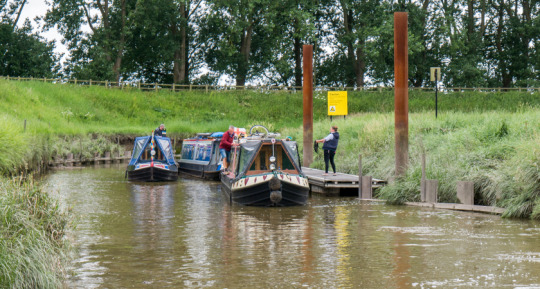
Once on the holding moorings, it’s a case of waiting for the all clear from the CRT lockies to head off. This time we were the first to go.
Once through the sea lock, it’s a short run out to open water, up the estuary, and onto the River Douglas.

Gareth was quite happy to take us all the way over, which gave the captain a bit of a break and time to put his feet up (just joking).
We were lucky enough to time the tide so it was exactly the same level as the canal, which meant we could pass straight through the lock. The following boat managed as well, but only after having to put the power on.
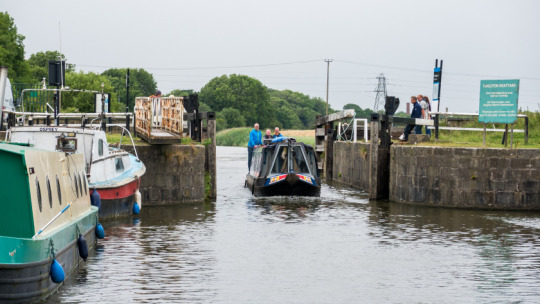
We didn’t realise until afterwards it was narrowboat Seyella (fellow boating bloggers ‘Seyella’s Journey) with passengers Doug and James, who blog on NB Chance, aboard.
Such a fantastic experience – we absolutely LOVED the Lancaster and hope one day to return with more time and knowledge. It was wonderful to share some of the journey with Andy and his son Matt, and Jim and Hilary and her mum, and finally Gareth and Michaela who we thank profusely for providing lunch and for being so inspiringly impetuous ….
Where are we now in real time?
We’re currently in the Northwich area, awaiting news on a lock closure at Malkin Bank as to our upcoming travels. We’ve heard there’s some challenges at Middlewich due to low levels of water. And we’re expecting our next kiwi guests, Rod and Tracey, to arrive on Sunday – we’re just not exactly sure yet the location of that meet-up!
Carnforth to Tarleton and many memories in between … You guessed it! We've become way behind here once again ... The weather's been amazing these past few weeks, so unsurprisingly sitting indoors writing blog posts hasn't featured at the top of our 'to action' lists.
#Carnforth#Christ Church Church Glasson#Doctor Zhivago#Douglas Twiddy#Glasson Branch#Glasson Docks#Hest Bank#Hest Bank railway crossing#Heysham Nuclear Power Plant#Labyrinth#Lawrence of Arabia#Lune Aqueduct#Lune Estuary#Morecombe Bay#Morecombe Bay Cockling Disaster 2004#Port of Lancaster Smokehouse#Raiders of the Lost Ark#Return of the Jedi#Ryan&039;s Daughter#The Bounty#The Plume of Feathers
6 notes
·
View notes
Text
Boats......
"Believe me, my young friend, there is nothing – absolutely nothing – half so much worth doing as simply messing about in boats" - Ratty - Wind in the Willows.
So we swapped the campervan for a boat we have boated before in both cruisers and narrow boats and love it. In fact Simon has a long term plan to live on a boat…….oh as well as live in a mobile home…….oh and in a cottage that needs renovating……and finally on a plot of land where we actually build our house from scratch!
We've boated before on the beautiful Norfolk Broads, once in summer, which is very busy, but amazing to see so many boats and once in Spring which was very quiet and more relaxing. We've also been on the Oxford Canal with the excitement of using locks but also the daily worry of not dropping the 'windlass' - that's the bit of equipment essential for opening the locks. We've also been on the Union Canal in Scotland via the engineering marvel that is the Falkirk Wheel - essentially a rotating boat lift that replaced a staircase of locks that took a lot of time and energy to navigate. Doing this in a barge was exciting and scary for those a little uncomfortable with heights.
For this boat trip we started in Ely in Cambridgeshire with our boat hired from a boat yard on the Great River Ouse. Ely is a city but it feels like a market town. The cathedral is worth seeing inside and out, the architecture, paintings and fittings are spectacular. Only a short distance away from the centre is the river, which is a hive of activity for boaters and the locals. We spent a day and night in Ely walking along the river, site-seeing and trying the local bars and restaurants. We had one of those days when you blow the gap year budget because it's sunny, laid back and a relaxing place to be. We made up for the little blow out by spending zilch for the following few days by staying on the boat and relying on the supplies from home - emergency pasta and gin cocktails (Portsmouth gin at that - a present from a friend on finishing work for the gap year - chin chin Jacque Ashton).
The boat was a cruiser with two 'wee' cabins, one had seats and a mini kitchen and the other cabin had a bed a wash basin and separate compartment with shower and toilet. A tight space but palatial compared to the van. The compartments were separated by the central driving compartment, where we alternated the role of captain and ships mate throughout the week, although someone took the role of captain much more seriously than the other. The bed was a strange triangular shape with the head part under the bow of the boat (that's the front). On night one claustrophobia set in for me as the space was small, confined and difficult to get out of without doing a backflip. So whilst Simon stayed put, myself and the dog moved to the front compartment where you could convert the seats to two single beds. I had one, Skyler had the other…..until about 5am when Skyler decided he'd jump onto mine and we'd share - a tight squeeze but there's nothing quite as nice as a doggy spooning you.
For a week we cruised at 4-7 miles an hour along the River Great Ouse and its tributaries the Little Ouse, Wissey, Lark and Brandon Creek. We also went along The Cam where you can go as far as Cambridge, but we had decided not to visit the bigger towns or cities on this particular trip.
Boating is best enjoyed if you sit back and just watch the views go by. As a commuter I spend 2-3 hours a day travelling along the motorways and busy roads of Lancashire, often on autopilot with the main objective of getting from A to B as quickly as possible; A and B being home and work. I spend little time taking in the scenery as a matter of safety. With a small boat it's very different, there's not a lot you can do other than chill out and spend a lot of time looking at the scenery. Once you do that you begin to see in great detail the views, the wildlife and nature in action. Swans teaching their signets the ways of the river, cows chewing the cud and flicking their tails, herons watching majestically from the banks, dragon flies frantically chasing your boat, ripples shimmering and breaking against the waterlilies and disturbing for a second the stillness of the yellow flowers sprouting from them. The vistas stretch for miles across fields with tiny villages recognisable by their church spires poking out on the horizon and then suddenly the vistas disappear and you are enclosed by reeds or trees of every variety, shaded but penetrated by flashes of sunlight. Every so often there is the excitement of a bridge - or rather getting the boat through it without hitting the sides. Then comes the mooring up!!!! Mooring is actually a simple task if logic is used and all remain calm - steer the boat in, knock off the power, secure the front end and then secure the back end, job done. Alas, for us mooring seems to cause a lot of tension, a row often errupts with choice language, raised voices and a lot of disagreement about who's fault it was the mooring didn't go to plan!
Arguments aside there is something really lovely about being tied to the river bank, knowing you are there for the night far from civilisation in the peace and tranquility of the countryside all 'alone'. That is unless you listen to local folklore which can make you a bit nervous about the 'alone' bit. Local folklore has it that at night out on the paths near the waterways and fens of Cambridgeshire and Norfolk there is a ghostly presence known as the 'Black Shuck'. Described as a large black hound with red eyes as big as saucers that prowls about howling so as to make your blood run cold. Apparently though there are tales of the Shuck helping out the fairer sex who may find themselves lost in the fens and that he has on occasion guided them back to the safety of the villages. I could find no details though on what he does to men, making Simon a little nervous when conveniently I was already cosy on my PJs when he had to take Skyler out on the dark mooring for his before-bed pee…………ARH-WOOOOOOOOOOOOOOOO!
Of course you don't need to sleep out in the middle of nowhere with wild beasties. Along the rivers and canals are pretty villages and pubs where you can enjoy the local hospitality, often these moorings are busier with other boaters and locals so there is that sense of safety in numbers if you don't like being in more secluded places. Littleport is one such place, an hour or so up the river from Ely, we stayed there on our first night, crossing a little bridge from our mooring to the Swan on the River,where we had a few glasses of the amber nectar and a lovely meal. Word of warning though, remember you are on a river and you need to be able to walk in a straight line at closing time back to your mooring, otherwise you'll be getting a bit closer to those waterlilies mentioned earlier than you hoped.
Of course being on the boat doesn't mean just looking out and doing nothing, being on the boat is a perfect time to indulge in pastimes you might not get a lot of time to do in your busy working week. There's talking, reading, writing, playing games, taking photos, drawing, painting, maybe like me learning sailing knots and discovering local folklore. Cruising for 3-4 hours a day seemed about right for us as it gives you the opportunity to do some off boat activities too. Off the boat you can potter around the local area or walk for miles along the river paths (essential for doggy owners - remember the dog needs to pee and unless very clever can't cock their leg over the side). We are suckers for pots of tea and cakes at the village tea rooms and love to get a little mellow at the local pubs. Whilst cruising you may also come across a local markets, village fetes or visitor attractions.
We visited Denver Sluice Complex, a historically controversial piece of waterway engineering built to prevent the often catastrophic flooding of the villages and fens around the rivers in this low level part of the country. Historically this lock and sluice system didn't meet the need it was intended for and blame was put on insufficient funding and miscalculations in its engineering structures (even John Rennie had a go). This resulted in more flooding and difficulties for village and boating trades over many years. Now it is in working order and whilst some feel it is still not as a good as it should be it has prevented further widespread flooding of the area. As for the traditional boating trades, as seen with many other areas across the country an increase in rail and road networks has meant a decline in these trades leaving the rivers free for mainly leisure boating. The railways are definitely evident in the area as the lines cross the river in several places and we did moor up very near the train line on a couple of occasions. Not everyones cup of tea, but we both love the sound of trains and watching with interest the origins of the freight on the freight trains, these often come from far and wide reminding us of how big the world is away from our boat and little piece countryside mooring.
It was strange (van owners will understands this), but I felt a little guilty abandoning the campervan for a boat at the beginning of the week. However, by the end of the week we were sad to be leaving the boat behind after such a relaxing week and would have loved to carry on for longer, but boating is not cheap unless you own the boat of course.
We agreed as we left that if we ever got a boat it would be a barge rather than a cruiser, with a tiller and not a wheel, the bed would be big and square, not a triangle and we'd have our mooring on the river not in a marina, it would be next to a field and a railway line with a short walk to the village tea shop and pub. Simon as always has begun researching this and will shortly bombard me with results in his bid to go and live on a boat. Unfortunately he is a hoarder and you can't live on a boat if you are a hoarder, so I have given him a load of charity bags in a bid to get him to have a clear out….. Watch this space!!!!
One good thing about getting home was having the luxury of a proper bed to sleep in, although for the fist night I seemed to retain a sense of gentle rocking like I was still on the boat, but maybe that was Skyler pushing his luck and wriggling in for a spoon!!!
So again with the words of Toad from Wind in the Willows it's back to the magnificent van (cart) for our next adventure in the gap year.
"There’s real life for you, embodied in that little cart. The open road, the dusty highway, the heath, the common, the hedgerows, the rolling downs! Camps, villages, towns, cities! Here today, up and off to somewhere else tomorrow! Travel, change, interest, excitement! The whole world before you, and a horizon that’s always changing! And mind, this is the very finest cart of its sort that was ever built, without any exception."
3 notes
·
View notes
Photo

Fancy just getting away from it all? How about this lovely, two bedroom waterside accommodation? 😍 Set within the vast network of rivers and lakes that make up the picturesque area of England known as the Norfolk Broads. This lovely little lodge which, sleeps up to 4 people is situated at the waterside and provides a relaxing break from the hustle and bustle of everyday life. This little lodge also comes with a row dinghy to explore the surrounding waterways at your leisure.😍 Exploring the area is perhaps best achieved by water, since many of the waterways are kept navigable, the perfect way to slow the pace, all you need to do is sit back and drink in the natural scenery - as long as someone agrees to do the rowing that is! Nearby, the village of Wroxham on the banks of the River Bure is home to a range of retail and dining outlets. Within the wider area of Norfolk, the lodge is also within reach of the rural attractions of Broadland. Date: 22/08/20 7 Nights £759 For more info please contact me and register on my website below for more deals... Lauradaykin.inteletravel.uk [email protected] 07414566036 📞 #wroxham #norfolk #cabin #logcabin #relaxation #holidays #travel #travelagent #travelagency #teambuilding #teambuilder #memories #family #friends #vacation #workfromhome #mumof2 #bossmum #inteletravel #inteletravelagent #sunshine #vacation #memories (at Norfolk) https://www.instagram.com/p/CBz5AYOJGYC/?igshid=18zvenglu084c
#wroxham#norfolk#cabin#logcabin#relaxation#holidays#travel#travelagent#travelagency#teambuilding#teambuilder#memories#family#friends#vacation#workfromhome#mumof2#bossmum#inteletravel#inteletravelagent#sunshine
0 notes
Photo

New Post has been published on https://vacationsoup.com/autumn-days-out-in-norfolk/
Autumn Days Out in Norfolk
Norfolk is a beautiful place to visit in the autumn. Whether you want a dose of nature and experience the changes of the seasons. Or if you are here for your family’s half term holiday there is plenty do to whatever the weather. Here is my local guide to the best places to head to this autumn in Norfolk. This blog post focuses mainly in East Norfolk where the Norfolk Coast meets the Norfolk Broads. I am based in Winterton-on-sea.
Experience Nature
Norfolk is a great place to be if you want to watch the seasons change and experience wildlife.
Visit the seals and coast.
A must visit if you are in the local area. The seal colony at Horsey has been growing steadily for some years now. The colony has harbour seals or common seals as well as grey seals. In Autumn we see both types of seals on the beach at Horsey in large numbers (and increasingly at Winterton-on-sea). Grey seals have their babies on the beach from mid-November onwards. Last year over 2000 grey seal babies were recorded. If you visit Horsey this autumn you should get to see both types of seals on the beach. The beach at Horsey will be closed to the public from the end of October, to protect the baby grey seals who can’t go into the sea until they are over 6 weeks old. You can view the seals from a number of viewing platforms on the dunes. I have written a detailed blog on how to get the best out of a visit to see the baby seals here.
Seals at Horsey
Top tip: Tracking the seals down can be trickier. I tend to ask people when I arrive where they are and then head to the right part of the beach. Please note there is no public toilet at Horsey. Poppylands the 1940s tea room, at Horsey gap, is a great stop-off point - they do great cake.
Visit the Broads National Park
The beautiful Broads make for excellent wildlife spotting and days out in nature. I’d recommend hiring an electric boat from Martham Ferry Boat company and experience Martham Broad, Horsey and Hickling. At dusk you can hear the pink footed geese and watch the cranes fly over. Ross' wildlife tours, operating out of Horsey to rave reviews, are back for half term (kids and dogs welcome). Text Ross on 07791526440 for availability. Or visit Hickling National Nature Reserve. At Strumpshaw Fen nature reserves you can book your own personal wildlife safari with the RSPB warden.
Tip: If you hire a boat, always go electric. Quiet and no fumes - why wouldn’t you?
Top picnic spot and place to see brilliant autumn colours
How Hill.
My favourite place in the Broads. It has everything (apart from a tea room) that you could want for a picnic spot including mini museum, boat trips, and nature reserve. I made a little film of my friends and family enjoying How Hill.
youtube
On October 23 there is a delightful Craft Fayre on at the house. 11am-4pm with refreshments, craft, and activities for kids.
Tip: there is lots to How Hill but it’s easy to miss. Check to see if the main house and gardens are open. It will say on a notice board outside the house and seek out the ‘Secret water gardens’ which will be beautiful in autumn. You enter them via the woods heading north from the house.
Great options for kids over the half terms weeks.
October 18-26 - Norwich Science Festival at the Forum
I love the Norwich science festival. This year it has nine days of inspirational exhibitions, sensational shows and hands-on science activities for all ages and all levels of knowledge. It is an absolute must to visit with your young scientists. There are, mostly, free shows for kids but book in advance. Find out more about the Norwich Science Festival
Tip: The Forum in central Norwich has drop in events, these tend to be busy but good to dip into either side of a show or workshop.
October 19-31 - The Glorious Glowing Lantern Parade at BeWILDerwood
Always one of my top recommendations for kids from 3 – 11 years old especially for the half term week. Apparently, as dusk falls, BeWILDerwood will glow in a magical light extravaganza. See the woods in a fantastical new light as all the inhabitants come out to celebrate a Glorious Glowing Lantern Parade! Check out this short film on the parade
youtube
Tip: I’d recommend arriving around 1 or 2pm if you want to take part both in the lantern parade and in the usual activity. There is a good 5 hours of fun on a normal day. Outside of half term it's open at the weekends.
October 23 - Family Survival School 10:30am - 3:30pm at Sheringham Park
Our friend, Rob, at Sheringham Park puts on marvellous family days at the National Trusts beautiful Sheringham Park and this event sounds great. "Hone your survival skills with a bitesize bushcraft adventure! Build a shelter, light a fire, forage for food and learn how to navigate with a map and compass. Cooking on a campfire is one of the '50 things to do before you are 11¾'"
Tip: You need to book. Sheringham is a great place to take bikes for kids or just wonder around the beautiful park land and then head into the town for fish and chips on the beach at dusk
October 18-27 - Halloween Hoot at Hirsty's Family Fun Park
If you are looking to entertain your family and want the pumpkin carving to not happen at home, try the Halloween Hoot at Hirsty’s Famiy Fun Park. Pick and carve your pumpkin on site, wheel it back to the carving tent and start creating your own masterpiece - then try out other craft activities before playing in the Fun Park.
Tip: Alternatively you pick your own pumpkins at the Tacons farm shop in Rollesby and even take part in their pumpkin fun run on the 26th October.
October 19-November 3 - Fang-tastic Family Fun at Trick or Tweet at Pensthorpe Natural Park
We love Pensthorpe’s beautiful gardens and brilliant indoor and outdoor play areas. This half term you can join Pensthorpe Natural Park's Trick or Tweet which will allow families to discover the grim and gruesome side of nature and celebrate the magic of autumn outdoor.
October 19-27 - Fairhaven Fairy Folk Halloween Trail
These guys always put on great events. Throughout half term you and your kids can hunt for little fairy doors in the trees and discover which fairies and spirits live there. Fairhaven helps reveal how in recent centuries, Halloween has replaced the ancient celebration of Samhain, when our Celtic ancestors celebrated the end of summer and the beginning of winter. The Fairy Folk Halloween Trail is free with garden entry plus 10p for the trail sheet and runs every day from Saturday, October 19 to Sunday, October 27.
Tip: Their café is great and reasonable. Dogs allowed on leads.
October 19-27 - Spooky Fun at Pumpkin Festival, Wroxham Barns
Perfect for younger children, combine a visit to Wroxham Barn’s junior farm with their pumpkin festival. You'll be able to make potions and wands with your kids. There are prizes for the scariest costumes.
October 19-November 3 - Halloween Spooktacular 2019 at The Hippodrome Circus
If you are anywhere near Great Yarmouth we’d recommend a trip to the Hippodrome and see Great Yarmouth’s permanent circus spectacle. Ideal for families with kids 6 plus.
Arts and Crafts Fairs
Norfolk has an increasingly good arts and craft movement. These are a few local ones I’d really recommend.
October 19 20 Thrigby Arts Festival 10am – 4pm (free)
Beautiful crafts from pottery, weavers, upholsters – great gifts. See their Facebook page here. I go every year, there is hand on stuff for the kids to do and I even manage to buy some early Christmas presents.
October 23 How Hill Trust Craft Fayre 11am – 4pm adults £3
A large range of local craft stalls and demonstrations. Gardens open. Orienteering activity and dyke dipping for children. Homemade cakes, refreshments, and light lunches available throughout the day.
November 3 Blue Bird Handmade Market, Royal Assembly Rooms, Great Yarmouth. 11am- 3pm free or Nov 17th Yarmouth Race Course 11am- 3pm
Range of quality local crafts at these delightful Christmas markets. Find out more on their Instagram pages
24 November and 1 December Norwich Makers Market, Norwich Assembly House 11am- 4pm
Wonderful gifts are available from the stalls of these talented people. Follow them and see who is participating at the market via their Instagram page
#BroadsNationalPark#HolidayInWintertonOnSea#Norfolk#VacationInWintertonOnSea#VacationSoup#WintertonOnSea
0 notes
Text
What is Intercultural Communication and Why is it Important?
WATCH: How Culture Drives Behaviours | Julien S. Bourrelle | TEDxTrondheim Listen for the idea that how we see the World through cultural glasses. By changing the glasses you can change the way you interpret the World. (12:07 minutes)
https://www.youtube.com/watch?v=l-Yy6poJ2zs
A Brave New World
We live in an increasingly globalized world. Technology enables us to do business just as easily with our neighbors as with a businessperson thousands of miles away from us. Knowing how to navigate cultural differences is an increasingly valuable skill that will make you a more valuable employee. Encounters among members of different cultures frequently fail simply because of basic cultural differences, such as the importance of time, proper greetings, or even the use of eye contact.
This course is designed to help you identify how to become a better communicator in these sorts of cross-cultural situations. You will learn about barriers to successful communication that involve cultural differences. You will also learn more about your own communication style and how it can be developed to facilitate more successful intercultural encounters. Though some of this course addresses a Western/U.S. perspective, much of the course focuses on characteristics of specific cultures and how generally one culture may adapt to another, regardless of which cultures they may be.
While some information is presented from a Western perspective, the information in this course can be applied to other cultures. You should consider how your culture fits in terms of interacting with other cultures learned about in this course. This course builds on other communication courses. You will learn to apply various skills that you have developed in other courses, including the ability to analyze an audience and the context of the communication in an intercultural encounter. Likewise, skill and insights into message development and the ways in which different groups receive and interpret messages will take on new meaning when applied in an intercultural context.
A portion of the information in this course will refer back to the pioneering work of Hofstede and his cultural classifications. Geert Hofstede is one of the foremost influential scholars in the discipline of cultural studies, particularly organizational culture. His pioneering work, such as the cultural dimensions theory, has been the basis for subsequent research and the growth of the field and understanding of how members of differing cultures interact.
Commonly accepted academic and applied definitions of intercultural communication
As you can see, this area is complex and dynamic. The term “intercultural communication” represents broad ideas that are difficult to express in any one fashion. Here are several working definitions as starting points for exploring this topic:
Intercultural communication refers to the communication between people from two different cultures. (Chen & Starosta, 1998:28)
Intercultural communication is a symbolic, interpretive, transactional, contextual process, in which people from different cultures create shared meanings. (Lustig & Koester, 2007:46)
Intercultural communication refers to the effects on communication behavior, when different cultures interact together. Hence, one way of viewing intercultural communication is as communication that unfolds in symbolic intercultural spaces. (Arasaratnam, 2013:48)
Communication among Cultures
As you have surely experienced many times, communication between members of the same culture can be challenging and can often be hampered by misunderstanding, confusion, and a lack of shared meaning. These miscommunications can take place despite the fact that members of the same culture often share beliefs and worldviews. Miscommunication can be prevalent despite the appearance that people are communicating successfully, because they share a language. Communication failure stems from issues of individualism versus collectivism (individual orientation vs. group orientation), masculinity versus femininity, power distance (relationships between those with and without power), uncertainty avoidance (level of comfort with uncertainty), and long-term versus short-term orientation.When individuals from different cultures engage in communication, the opportunity for miscommunication multiplies.
In his book Intercultural Communication A Contextual Approach, James W. Neuliep wrote;
The list of variables that can come into play grows exponentially as the communication situation changes from a shared cultural perspective to two or more cultures represented by the people talking together. For example, if you are in a business meeting with others, including a man from Nigeria, you might notice some communication differences between the man and the others in the meeting. If he is younger or a subordinate to you, he will likely avoid eye contact. While you might consider this a sign of nervousness or deception, he would likely be avoiding eye contact out of respect for you.Understanding some primary differences in cultural communication practices can serve as a starting point for developing intercultural communication competence by helping you better understand how to communicate among cultures.
The author continues:
The cultural context in which human communication occurs is perhaps the most defining influence on human interaction. Culture provides the overall framework wherein humans learn to organize their thoughts, emotions, and behaviors in relation to their environment. Although people are born into a culture, it is not innate. Culture is learned. Culture teaches one how to think, conditions one how to feel, and instructs one how to act, especially how to interact with others—in other words, how to communicate. In many respects, the terms communication and culture can be used interchangeably. Yet the influence of culture on human interaction is paradoxical. As we conduct our daily lives, most of us are unaware of our culture; however, culture influences our every thought, feeling, and action.
Anthropologist Edward T. Hall said that culture hides more than it reveals, particularly from its own members. Australian anthropologist Roger Keesing argues that culture provides people with an implicit theory about how to behave and how to interpret the behavior of others. We often think of a culture in terms of its geography; for example, we think of Saudi Arabia as a hot, desert culture and of Siberia as a cold, mountainous one, according to Neuliep. “But culture is more a human phenomenon than a geographic one,” he states. And while geography certainly affects how people live within a particular culture, the people, more than the geography, are what constitute culture. So when you think of a culture, think about the people. It is also important to understand that cultures of people are not static but, rather, dynamic.” Cultures change; they are fluid, always moving.
There are five dimensions of cultural variability: individualism–collectivism, high–low context, value orientations, power distance, and uncertainty avoidance. Click on each phrase for further explanation. Each of these dimensions affects how people communicate.
The cultural continua allow us to represent the dimensions of cultural variability as continuous and varying in magnitude by degree. In other words, no culture is purely and absolutely individualistic or collectivistic. Instead, a culture may be more individualistic or more collectivistic than some other culture. Another important point to make is that these cultural dimensions of variability are not opposites; that is, a culture in which a large power distance is practiced should not be thought of as the opposite of a culture in which small power distance is practiced. In some cases, dimensions of cultural variability may coexist in cultures. In addition, as already mentioned, cultures are not static or fixed in time; many cultures are in a state of great transition. Thus, a culture that was once considered collectivistic may now be considered individualistic.
For example, Japan is considered a collectivistic, group-oriented society, Neuliep says. However, since the 1950s, Japan has been strongly influenced by Western culture: “Many Japanese scholars have observed that the younger generation of Japanese, while still considered collectivistic, is more individualistic than that of their parents and especially of their grandparents.” He adds that although the United States is considered very individualistic, many U.S. businesses and corporations employ collectivistic management models in the workplace, focusing on teamwork and cooperation. Finally, when we label a culture as individualistic, that does not mean that every person in that culture is an individualist.
The United States, for example, is considered an individualistic culture, yet groups within the United States are collectivistic. While reading through this chapter, remember that cultures are not static. Cultures are dynamic, continuously developing and evolving. Individualism–Collectivism Perhaps the single most studied dimension of cultural variability used to compare and contrast cultures and microcultures is individualism–collectivism. Cultures falling on one side of the continuum are individualistic, while those falling toward the other side are collectivistic. Cultures falling at the midpoint might possess both individualistic and collectivistic characteristics. Regardless of culture, most persons carry both individualistic and collectivistic tendencies to some degree. The difference is that in some cultures individualistic tendencies dominate, while in others collectivistic tendencies dominate.
WATCH: YouTube: Norfolk State University: William Hart’s “Collectivism/Individualism through Dance.” Listen for the distinctions between individualism and collectivism. The perspective of thinking about yourself first versus the group first is a difference among some cultures. (2:54 minutes)
https://www.youtube.com/watch?v=bO9TyiAj7BM
Rewards and Barriers to Them
In Identifying Barriers to Effective Intercultural Communication, Kathy McKeiver, writes:
A growing international student population enhances university campuses by contributing to a diversified community and providing exposure to new cultural perspectives. However, the rewards don’t end there. Students and staff who engage in intercultural interactions tend to experience gains in communication skills, the ability to empathize and an openness to new ideas. Consistent intercultural interactions also increased individuals’ likelihood to challenge personal beliefs and embrace new perspectives.
The article also states:
One such barrier is ethnocentrism. Any intercultural interaction will be influenced by an individual’s ethnocentrism, or the belief that one’s culture (“in-group”) is superior to another’s culture (“out-group”). All humans are to some extent ethnocentric, falling somewhere on a scale between “low” and “high” ethnocentricity. High or low levels of ethnocentricity influence an individual’s ability to successfully communicate interculturally. Individuals with high ethnocentricity will experience the largest communication barriers with those who are different from them. Highly ethnocentric individuals may feel “suspicious, defensive, and hostile” toward international students, especially students who have different social and cultural norms from the in-group.
However, ethnocentricity is not always negative. Those with low ethnocentricity may feel “curious, interested, and inspired” by their intercultural interactions and as a result, experience the benefits of increased intercultural competence. International students report a lack of cultural sensitivity coupled with negative attitudes towards them as their biggest barrier to effective intercultural interactions. Given this, personal awareness of our own ethnocentricity and its effect on our ability to work with students suddenly becomes more important. ... Levels of ethnocentrism are closely connected to intercultural communication apprehension, another communication barrier.
We are dealing with intrinsic parts of our human nature. Ethnocentrism is the act of judging another culture based on preconceptions that are found in the values and standards of one's own culture. This often arises when language, behavior, customs, and religion are the focal point. These aspects or categories are distinctions that define each ethnicity's unique cultural identity. We grew up with culture customs, values, and behavior from people around us; and because of this, when we see a different set of customs and traditions from other cultures, we sometime fail to understand and acknowledge the unique nature of other cultures.
We tend to compare, evaluate, and even judge from our own point of view. To think that your culture is better than others and judge other culture based on your culture’s values and traditions is a negative example of ethnocentrism. Due to such beliefs, many people are blindsided from seeing things from another perspective.
The term ethnocentrism was first applied in social sciences by American sociologist William G. Sumner. In his 1906 book, Folkways, Sumner describes ethnocentrism as; "the technical name for the view of things in which one's own group is the center of everything, and all others are scaled and rated with reference to it." He further characterized ethnocentrism as often leading to pride, vanity, the belief in one's own group's superiority, and contempt for outsiders.
Over time ethnocentrism developed alongside the progression of social understandings by people such as social theorist, Theodore W. Adorno. In his The Authoritarian Personality, he and his colleagues of the Frankfurt School established a broader definition of the term as a result of "in group-out group differentiation.'. The theorists posit that Ethnocentrism "combines a positive attitude toward one's own ethnic/cultural group (the in-group) with a negative attitude toward the other ethnic/cultural group (the out-group)". Both of these juxtaposing attitudes are also a result of a process known as Social Identification and Social Counter-Identification.
WATCH: YouTube: Cross Cultural Communication on The Culture of Time | David Solomon | Instructions: Watch this video featuring David Solomon, director of the consulting organization Cross Cultural
Communication. He explains how time is viewed and valued differently by members of different cultures. As you watch the
video, consider how you perceive time and how you would react in situations where others perceive time differently. (4:26 minutes)
https://www.youtube.com/watch?v=o1bICOV3Lug
Moving Forward
Our course will compare attitudes and communicative behaviors of service people from different ‘cultural’ backgrounds, where ‘culture’ is understood as identical to nation (‘British’ and ‘Italian’). We will also study individuals from different cultural backgrounds in interaction, and ‘culture’ is seen as similar to ethnicity and/or race (‘Korean immigrants’ and ‘African Americans’).A third major area will be examining how other people are talked about and cultural belonging is discursively constructed. Here culture is seen as a product of the text instead of a social variable.
Effective and efficient intercultural communication fundamentally requires intercultural awareness. This is defined as an understanding that different cultures have different standards and norms. Further, those who practice it must understand that individuals are shaped, but not trapped, by their cultural background. And sometimes, we need to meet people more than halfway.
***
ADAPTED FROM: Saylor Academy. (2019). Intercultural Communication. Retrieved from https://legacy.saylor.org/comm311/Intro/
LICENSE: Creative Commons Attribution 3.0
Other References
Arasaratnam, L. A. (2013). Intercultural communication competence. In A. Kurylo (Ed.), Intercultural communication: Representation and construction of culture (Chap 3, pp. 47-68). Los Angeles, CA: SAGE Publications.
Chen, G. M., & Starosta, W. J. (1998). Foundations of intercultural communication: Boston, MA: Allyn & Bacon.
Lustig, M. W., & Koester, J. (2007). Intercultural competence: interpersonal communication across cultures (5th ed.). Shanghai, China: Shanghai Foreign Language Education Press.
Neuliep, James W. (2015) Intercultural Communication A Contextual Approach: Thousand Oaks, CA: Sage.
0 notes
Text
Mostly Delight
Headwinds
Late October, Breakfast, Hampton, South Carolina
I moved my hand away from the top of my mug and nodded to the waitress. “This coffee is wonderful,” I smiled.
“I’m glad y'all enjoy it,” she smiled back at me and filled my mug.
About an hour later, In the air over Fayetteville, North Carolina
There is a twenty knot headwind.
Another hour later, near the southern tip of the DelMarVa peninsula
There is a thirty knot headwind, and we are beginning to think about a fuel stop.
A half hour later, over the Atlantic Ocean
Roy and I were two thousand miles from home, in chairs in the sky, in a plane he built. This absolutely overwhelms me with delight. And the best part of the day is still to come.

For an added bonus, I could see many of the places that were navigation references used during my training for my Coast Guard Captain's License. The huge airports of Norfolk International and Oceana Naval Air Station were off to the west. I recognized the curve of the bay, and the bridges that become tunnels half way across the bay. And there was the ocean, endless water and whitecaps moving across the bay.
Roy pushed the throttle in and started to climb over a thin layer of puffy, white clouds.
I reached for his hand… “I seriously have to pee…” I said. The coffee from breakfast - the wonderful dark brew that I couldn’t resist have three cups of -had hit bottom.
“Now?”
“Yes, now.” I squirmed in my seat and reached for the iPad, opened Foreflight and started looking for places to land.
“There’s an airfield,” I pointed ahead and to the left. Sun shone on broad, flat farms below us. White barns and a few houses dotted green farms, green crops, blue ponds, and blue estuaries winding in from the sea.
“That airport is off our beam now.” I wasn’t sure he’d heard me.
“I wished you’d told me before I started to climb.” He sounded annoyed. He poked at the AFS screen in front of him. “Can you wait?”
“No,” I shook my head. “You said we could stop.” I could hear the petulance in my voice.
He pulled the throttle back and pointed the nose down.
“What was wrong with…?” I pointed back over my shoulder. No point now. We were making for a different airport.
“I want to get fuel closer to Dover.” He held up his finger for ‘sterile cockpit’.
Our little plane bumped and rocked side to side in the turbulent cross-wind as we made our final approach. I held my legs tight. Please don’t pee in the plane, please don’t pee in the plane… The words ran in my brain like a rosary. Large, black crows scattered from the runway as we approached the numbers. I didn’t care about the birds. I did care about sitting in a wet spot.
I held my breath, then exhaled as we touched down.
Roy taxied to the fuel pump, shut the engine down, and cracked the canopy. I popped out without our usual landing-kiss. There wasn’t a soul around. The FBO was locked. I ran around to the other side. No door there. I ran back to the other door and banged on it. Nothing. No One. I ran around to the back of the building. Really, there was no back. Just the taxiway, and the runway, and beyond that farm land.
Isn’t airplane travel glamorous, I thought.
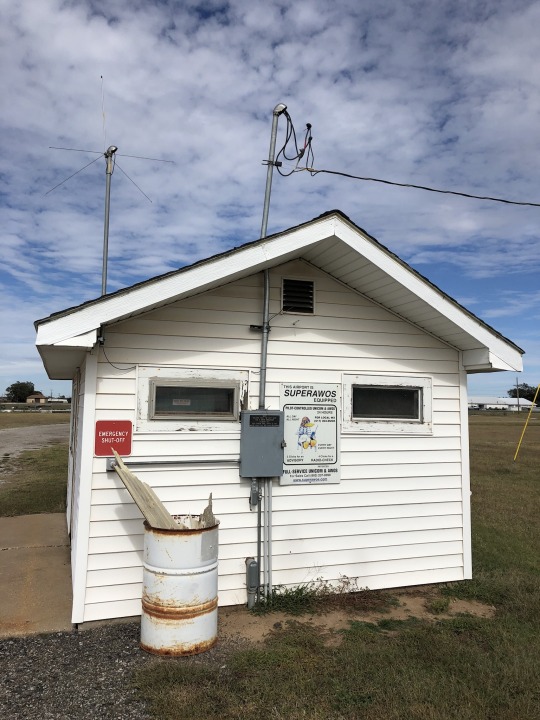
I hiked up my jeans and walked back to the plane. Roy was walking to the FBO.
“It’s locked,” I nodded my head toward the building. “Did you get fuel?”
He shook his head. “Fuel pump’s locked too.”
“How long to Dover?” I think in terms of time to destination, which has to do with the best part of the day being just ahead. For this, I’m willing to deal with the occasional abandoned FBO.
“About 470 nautical miles.” Roy thinks in terms of range, which has to do with if we’ll have the required minimum fuel when we get to Dover.
Late October, In the late afternoon of the day we began in Savanna, Georgia
This time I gave my darling husband a landing-kiss before popping out of the plane. The Best Part of the Day had arrived.
I ran through the terminal to the parking lot. My daughter was there, with her head in the backseat. She looked up and smiled. A little brown-haired girl next to her turned to see what her Mom was looking at.

“Grandma!” Ava, otherwise known as Gramma’s Princess, ran and jumped into my arms. I held her and planted kisses all over her face. My daughter, Gaela, held baby Logan in her arms. I put Ava down and hugged my daughter. “Hi Mom,” she said, and baby Logan smiled from her arms. And that, simply overwhelms me with delight.

#vansaircraft#vansairforce#vansrv7#eaa#experimentalaviation#generalaviation#experimentalaircraft#onebagtravel#travelwriting#travelblogger#travelphotography#iloveflying
0 notes
Photo

Chartering a Yacht For a Family Vacation at The Caribbean
Chartering a Yacht For a Family Vacation at The Caribbean – – There are many groups or tour firms that offer these kinds of trips that long, successful history with tourists and enable you to definitely explore the sea and it is fauna in a very green and adventurous – Of course the best thing is always to rent a spead boat and be able to navigate alone however, if this is not possible, you can always are based upon a specialist skipper can guide us in the most beautiful and extremely mindful of his place understanding that it exposes us unnecessary chance of failure in the autonomy movement from the boat Boat Safety Tips – Aside from this, you will find various sorts and sizes of yachts that you can select, so no matter if you’ve company or otherwise you are able to certainly find one that fits your tastes along with the form of adventure you would like to embark on – Yacht charter UK companies also charge reasonable renting, and that means you need not worry about leaving a tremendous dent on your budget – Charter companies also provide many destinations that one could choose from Yacht Charter in Spain – Norfolk Broads holidays are a good way of obtaining nature in its purest form – You can cruise through serene waters and go through the great thing about the sunlit skies as well as the roaring breeze – The panoramic view outside and plush interiors inside produce a perfect combination – You can get a feel of technology plus the rawness of nature – You are allowed to determine how we need to spend the day – You could either decide to cruise on the sundeck or relax inside fully equipped boat inside There is even an abundance of nightlife opportunities. However, the dolphin tours are the most magnificent inclusion of the exploration. These tours are run year-round and they offer afternoon and sunset tours which might be quite memorable. These boats are quite large with huge open deck and the beautiful overhead enclosure. There are seating arrangements for 70 people and 140 people can outstandingly feel the novel party rolling around in its open deck. Read Also – Rent a Yacht in Seychelles enterdavao.com – Negotiate using your head: Negotiating while procuring any boat is pretty common behavior and is thought to be a usual act. But ensure you usually do not make your habit. As at times you could see quote advertised pretty justified having no room for negotiation. You may be simply considering the costing, however, at the conclusion up paying additional without thinking about the discount. However, if you discover the boat has room for negotiations, be sure to do not lose this opportunity to do it. Don’t simply continue negotiating; create a justified one as easily acceptable with the seller. Remember you’ll find others too inside the row to make a bid.
#EnterDavao, #Sailing
0 notes
Text
2 for 1 subscriber offer for London Boat Show 2018 tickets
The London Boat Show will take place at the London ExCel 10-14 January, and you can take advantage of our 2 for 1 ticket offer now. Find out how
Credit: onEdition
Yachting Monthly subscribers can now get 2 for 1 entry to the 2018 London Boat Show.
The offer applies to advance London Boat Show tickets, which start from £15*.
Back for its 64th year, the London Boat Show returns from 10-14 January 2018 at ExCeL London, celebrating everything you can do and enjoy on the water.
The new five day format will feature more than 300 exhibitors.
New for this year will be the Practical Boat Owner Theatre (stand LB012), which will take place from the deck of a fully rigged Westerly Centaur. Well-known sailing personalities and equipment experts will be presenting regular illustrated talks, which are targeted at practical cruising sailors of all levels.
Confirmed speakers include the pilot book author, Rod Heikell, and renowned celestial navigator, Stokey Woodall. Practical Boat Owner’s regular columnists, Sam Llewellyn and Stuart Davies, along with budget boating guru, David Selby, and PBO’s editor Rob Melotti, will also be on stage.
The theatre is opposite the Time Inc stand LC014, where you can find the latest Yachting Monthly subscription deals, as well show exclusive prizes.
There will also be the chance to meet with the Yachting Monthly team on 11 January, to celebrate the relaunch of the new look magazine.
The boats will still be at the centre of the London Boat Show, and Jeanneau has already confirmed the debut of its Sun Odyssey 440. Beneteau, Churchouse Boats, Cornish Crabbers, Hobie Cat, English Harbour Yachts and Nestaway Boats will also be exhibiting, along with the likes of Sunseeker, Princess Yachts, Prestige and Rib Eye.
Continues below…
New look Yachting Monthly coming soon!
There is less than a week to go until the launch of the bigger and better Yachting Monthly. Find out…
Running alongside the London Boat Show will be two other sister shows – The Boating & Watersports Holiday Show and Bespoke London.
The new Lock & Waterside Pub will celebrate the UK’s inland waterways and the Broads in Norfolk, with displays of narrowboats, whilst the Beach Club & Activity Pool gives visitors the chance to learn the art of dinghy sailing, kayaking or Stand Up Paddleboarding. Sail Scotland, Cosmos Sailing and Sunseeker will be among the exhibitors at the holiday show, where visitors can book their upcoming watersports holidays or get inspired for their next adventure.
Bespoke London will offer visitors the chance to enjoy an element of luxury whilst indulging in a glass of champagne. This area of the show will accommodate global and boutique brands which reflect a boating lifestyle.
You can buy your tickets now from londonboatshow.com and access this offer by using the code YM15.
*Please note a £1.95 transaction fee applies per transaction not per ticket. Promotional offer 2for1 allows two tickets from £15 to use any one day between 10 – 14 January 2018 ends midnight 31 December 2017. Normal price £20 per person for advance Preview Day tickets and £15 per person for advance Standard Day tickets. Not valid in conjunction with any other offer. Excludes premium tickets. Ticket offer is restricted to two adult tickets per transaction. 15 years and under go free with paying adult, max 2 per adult ticket. Terms and conditions apply. See londonboatshow.com for details. All details correct at time of going to press. E&OE
The post 2 for 1 subscriber offer for London Boat Show 2018 tickets appeared first on Yachting Monthly.
Read Full Content Here
BoatlondonoffershowsubscriberTickets
The post 2 for 1 subscriber offer for London Boat Show 2018 tickets appeared first on YachtAweigh.
from http://yachtaweigh.com/2-for-1-subscriber-offer-for-london-boat-show-2018-tickets/
from https://yachtaweigh.tumblr.com/post/168075630246
0 notes
Text
2 for 1 subscriber offer for London Boat Show 2018 tickets
The London Boat Show will take place at the London ExCel 10-14 January, and you can take advantage of our 2 for 1 ticket offer now. Find out how
Credit: onEdition
Yachting Monthly subscribers can now get 2 for 1 entry to the 2018 London Boat Show.
The offer applies to advance London Boat Show tickets, which start from £15*.
Back for its 64th year, the London Boat Show returns from 10-14 January 2018 at ExCeL London, celebrating everything you can do and enjoy on the water.
The new five day format will feature more than 300 exhibitors.
New for this year will be the Practical Boat Owner Theatre (stand LB012), which will take place from the deck of a fully rigged Westerly Centaur. Well-known sailing personalities and equipment experts will be presenting regular illustrated talks, which are targeted at practical cruising sailors of all levels.
Confirmed speakers include the pilot book author, Rod Heikell, and renowned celestial navigator, Stokey Woodall. Practical Boat Owner’s regular columnists, Sam Llewellyn and Stuart Davies, along with budget boating guru, David Selby, and PBO’s editor Rob Melotti, will also be on stage.
The theatre is opposite the Time Inc stand LC014, where you can find the latest Yachting Monthly subscription deals, as well show exclusive prizes.
There will also be the chance to meet with the Yachting Monthly team on 11 January, to celebrate the relaunch of the new look magazine.
The boats will still be at the centre of the London Boat Show, and Jeanneau has already confirmed the debut of its Sun Odyssey 440. Beneteau, Churchouse Boats, Cornish Crabbers, Hobie Cat, English Harbour Yachts and Nestaway Boats will also be exhibiting, along with the likes of Sunseeker, Princess Yachts, Prestige and Rib Eye.
Continues below…
New look Yachting Monthly coming soon!
There is less than a week to go until the launch of the bigger and better Yachting Monthly. Find out…
Running alongside the London Boat Show will be two other sister shows – The Boating & Watersports Holiday Show and Bespoke London.
The new Lock & Waterside Pub will celebrate the UK’s inland waterways and the Broads in Norfolk, with displays of narrowboats, whilst the Beach Club & Activity Pool gives visitors the chance to learn the art of dinghy sailing, kayaking or Stand Up Paddleboarding. Sail Scotland, Cosmos Sailing and Sunseeker will be among the exhibitors at the holiday show, where visitors can book their upcoming watersports holidays or get inspired for their next adventure.
Bespoke London will offer visitors the chance to enjoy an element of luxury whilst indulging in a glass of champagne. This area of the show will accommodate global and boutique brands which reflect a boating lifestyle.
You can buy your tickets now from londonboatshow.com and access this offer by using the code YM15.
*Please note a £1.95 transaction fee applies per transaction not per ticket. Promotional offer 2for1 allows two tickets from £15 to use any one day between 10 – 14 January 2018 ends midnight 31 December 2017. Normal price £20 per person for advance Preview Day tickets and £15 per person for advance Standard Day tickets. Not valid in conjunction with any other offer. Excludes premium tickets. Ticket offer is restricted to two adult tickets per transaction. 15 years and under go free with paying adult, max 2 per adult ticket. Terms and conditions apply. See londonboatshow.com for details. All details correct at time of going to press. E&OE
The post 2 for 1 subscriber offer for London Boat Show 2018 tickets appeared first on Yachting Monthly.
Read Full Content Here
BoatlondonoffershowsubscriberTickets
The post 2 for 1 subscriber offer for London Boat Show 2018 tickets appeared first on YachtAweigh.
from http://yachtaweigh.com/2-for-1-subscriber-offer-for-london-boat-show-2018-tickets/
0 notes
Text
Top Navy admiral orders fleetwide investigation following latest collision at sea
By Anna Fifield and Dan Lamothe, Washington Post, August 21, 2017
SEOUL--The Navy’s top admiral on Monday ordered a fleetwide review of seamanship and training in the Pacific after the service’s fourth major accident at sea this year, a collision of the USS John S. McCain off Singapore that left 10 sailors missing.
The accident, which occurred Monday east of the Strait of Malacca about 5:24 a.m. local time, involving an oil tanker three times the size of the guided-missile destroyer, could be the Navy’s second deadly ship collision in about two months. On June 17, the destroyer USS Fitzgerald collided off the coast of Japan with a much heavier container ship, drowning seven sailors after a berthing compartment inside the ship flooded in less than a minute.
In addition, the guided-missile cruiser USS Lake Champlain collided with a South Korean fishing vessel on May 9 off the Korean Peninsula and the guided-missile cruiser USS Antietam ran aground Jan. 31 in Tokyo Bay, near its home port of Yokosuka, Japan.
Navy Adm. John Richardson, the chief of naval operations, told reporters Monday that he was “devastated and heartbroken” by the disaster. The ship is now moored at Changi naval base in Singapore, with the amphibious assault ship USS America arriving to provide support and assistance to the McCain’s crew.
Richardson said the series of accidents in the Pacific “demands more-forceful action,” adding that there is “great cause for concern that there is something we are not getting at.” He ordered Navy fleets across the world to take a day or two within the next week to review their procedures and training to make sure they are operating safely.
More significantly, Richardson ordered a separate investigation into how the Navy prepares its forces to operate in the Pacific.
“This will include, but not be limited to, looking at operational tempo, trends in personnel, materiel, maintenance and equipment,” Richardson said. “It also will include a review of how we train and certify our surface warfare community, including tactical and navigational proficiency.”
Richardson said he wanted a broad and diverse team reviewing operations as part of the investigation, with the Navy inspector general’s office, the Navy Safety Center and outside experts all assisting. The probe will be led by Adm. Philip S. Davidson, who leads Fleet Forces Command in Norfolk.
“This review will be on a very tight timeline,” Richardson said. “I want to get frequent updates. This requires urgent action. We need to get to it and take corrective action.” He added that he wants it concluded “in the few-months time frame.”
Richardson said the investigation of the collision will review all possibilities, including some that are seen as less likely by experts, such as an electromagnetic pulse (EMP) attack. He also said there is “no indication” that anyone aboard either crew deliberately caused the collision.
Richardson’s comments came as the Navy continued a search for the missing sailors that included searches of the route the McCain had taken and an effort to explore flooded areas of the ship.
Photos of the disabled ship arriving in port showed a large hole on its left, or port, side at the waterline. More than 18 hours after the collision, the Navy had not disclosed any progress on the hunt for the missing sailors, but a search of flooded areas of the ship was expected to commence again after daybreak in Singapore.
The McCain is an Arleigh Burke-class destroyer--named after the father and grandfather of Sen. John McCain (R-Ariz.) and nicknamed “Big Bad John”--that had been on its way to a routine port visit in Singapore after patrolling in the South China Sea.
Shipping data showed the Liberian-flagged merchant vessel Alnic MC was also on its way to Singapore when the ships collided before sunrise.
The 550-mile-long strait runs between the Malay Peninsula and the Indonesian island of Sumatra, connecting the Pacific and Indian oceans, and is one of the world’s busiest shipping lanes.
The Alnic has a gross tonnage of 30,000, compared with the McCain’s 8,300.
The collision caused significant damage to the hull, flooded nearby compartments, including crew berthing, machinery and communications rooms, the 7th Fleet said in a statement. “Damage control efforts by the crew halted further flooding,” it said.
Four sailors were medically evacuated from the McCain by a Singapore armed-forces helicopter and were in a hospital in Singapore being treated for injuries that were not life-threatening. A fifth sailor who was injured did not require further medical attention, the statement said.
On the McCain’s Facebook page, people were hoping for good news about the missing. “Praying all the sailors including my brother are safe & the missing are found!” wrote Natalie Bossio.
The China Daily, a state newspaper, took the opportunity to denounce the U.S. Navy’s activities in the South China Sea, where the United States and allies have been trying to keep Chinese expansion in check. China claims full sovereignty over the sea.
The U.S. Navy “is becoming a dangerous obstacle in Asian waters” while China is trying to boost navigational safety, the paper said in an unsigned editorial.
“Anyone should be able to tell who is to blame for militarizing the waters and posing a threat to navigation,” it wrote.
Singapore’s Maritime and Port Authority said that the tanker, which was carrying 12,000 tons of fuel oil, suffered damage 20 feet above the waterline but that none of its contents had leaked.
The collision Monday came just days after the Navy issued a damning report listing errors that led to the USS Fitzgerald collision.
The Navy said last week that it would discipline a dozen sailors who were aboard the Fitzgerald, including the top two officers and the top enlisted sailor, whose careers are almost certainly over. Adm. William F. Moran, vice chief of naval operations, said the sailors who were on watch in the ship’s bridge “lost situational awareness,” contributing to the collision.
0 notes
Text
There are fewer boats now #boatingholidays #holidaysafloat #halfterm #october2020 https://youtu.be/g_sMm3gB7Js
youtube
#youtube#norfolk broads#travel#travel photography#traveling#holidays#new video#staycation#nature#please subscribe#how to navigate the norfolk broads#beginners guide to the Norfolk Broads#autumn#youtuber viral videos#youtube trending#find me on youtube#youtuber new name same me
1 note
·
View note
Text
#october2020 #magicalwonderland #norfolkbroads Ludham Bridge in half term week https://youtu.be/eIndrddJQRA
youtube
#youtube#norfolk broads#travel#travel photography#traveling#holidays#new video#staycation#nature#please subscribe#how to navigate the norfolk broads#how to seo#youtuber viral videos#viral videos#social media viral
0 notes
Text
https://youtu.be/_XnthEKwbQA
youtube
#youtube#norfolk broads#travel#travel photography#traveling#holidays#new video#staycation#nature#please subscribe#broads police boat#norfolkbroads cruisers yachts sailing boats please subscribe to my youtube channel easterdailypress edp#sailing holidays#wind and sails#boat fails#how to navigate the norfolk broads#youtube trending#youtuber viral videos#love where you live#youtuber new name same me
0 notes
Text
Stokesby and Ludham in October half term https://youtu.be/StCWaeznYws
youtube
#youtube#norfolk broads#travel#travel photography#traveling#holidays#new video#staycation#nature#please subscribe#sailing holidays#norfolkbroads cruisers yachts sailing boats please subscribe to my youtube channel easterdailypress edp#richardson’s boating holidays’s#boating#how to navigate the Norfolk Broads#ludham bridge#Stokesby#youtuber viral videos#youtuber new name same me#youtube trending#thank you#october half term
0 notes
Photo

Enjoy Magical Holidays With Norfolk Broads Boat Hire
Enjoy Magical Holidays With Norfolk Broads Boat Hire – – If the body’s small, paddling a kayak narrower than 22″ or if he likes to stroke more vertically choose a 215cm – The high angle makes paddling considerably more efficient due to the fact the stroke is done more detailed the kayak, much more of the force is carried into propelling the kayak forward – The second most essential point is the paddling type of the individual – While seated with a kayak, one can possibly put his hands out touching the water, whatever the height through the individual – Brief paddles less complicated convenient pladding style on the vertical, shaft 45 degrees angle while the blade is underwater – Not long time ago, it turned out common to choose 230cm – A wider kayak may require engineered to be 5 around 10cm longer The Catamaran is a kind of boat that contains two hulls joined by a long structure that is a somewhat new review of the whole world of sailing for both leisure and sport although there is evidence of catamaran like structures being used by fisherman inside the Indian Ocean many centuries ago. Moreover, such a sailing has get a popular because of being able to attain high speeds due to the build which promotes stability. The catamaran can perform carrying a rather large numbers of people when compared with the same sized boat at the same time thereby increasing its attraction to sailors. – The couple of superior getaway spots in your community, Shinnecock Canal and Inlet, are already a beloved local fishing and swimming destinations due to their vicinity on the numerous marinas and yacht clubs – One also comes with vibrant heritage as a possible Indian exchanging invest the 18th and 19th centuries – The places consider the name from the Shinnecock Indian nation, an Algonquian-speaking tribe tightly associated with other clans across the Long Island Sound A luxurious and comfy holiday can certainly produce a big difference for your life. It will rejuvenate and revive the senses. It is a way of de-stressing yourself from the burden of mundane day-to-day activities. If you believe in unwinding, then, it’s take all your family members to get a ride, particularly, a spead boat ride. Read Also – How to Trust And Verify When You Are at Sea enterdavao.com – The chart plotter uses the GPS data to calculate boat speed and direction, along with determine enough time and distance for the destination or next waypoint. As all of this info is in real time therefore the sailor knows where his boat is. By this he continuously gets updates. The chart plotter is preloaded with the different maps of numerous locations also it can be edited at enough time of journey. Some chartplotters allow the navigator to hold countless routes at a time for future use also.
#EnterDavao, #Sailing
0 notes